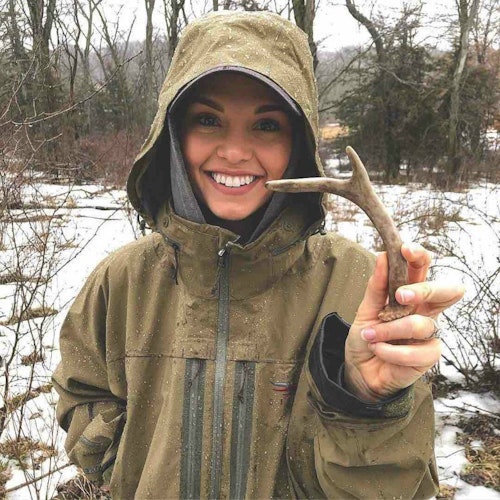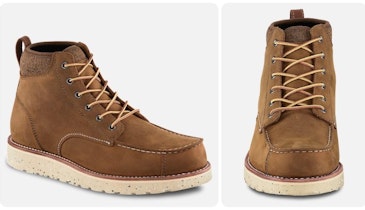
Creek and fence crossings are hotspots to find shed antlers because the action of a buck jumping can cause a loose antler to fall.
I don’t understand why some hunters don’t like searching for shed antlers. For me, shed season is a time of year when I can learn about the properties I hunt and the deer on those properties more than any other time outside of the actual hunting season. It’s a great break from cabin fever. After being cooped up over the winter months, just stretching your legs in whitetail country is a wonderful feeling. Most of all, I enjoy the search for every piece to the puzzle to compile the picture of just what bucks made it through another season.
Now there’s certainly a litany of positive aspects to shed hunting, but finding the time to get out can be difficult, too. Busy schedules, jobs and life’s obligations prevent most of us from dedicating unlimited hours and days in the field to search for these coveted chunks of bone. Time is a precious commodity; understanding where to focus your time and energy when looking for cast antlers can significantly increase your odds of striking shed gold.
South-Facing Slopes
It’s no secret that deer are hearty and tough critters. In the Midwest and North, when conditions are the harshest, deer can survive sub-zero temperatures for weeks at a time. A key to their survival during these brutal winter temperatures is strategically bedding to expose themselves to as much sunlight — available warmth — as possible.
Because this is the time of year when deer are dropping antlers, it’s common to find a concentration of sheds along south-facing ridges and slopes, especially if weather conditions have been severe. Specifically, on south-facing slopes look for areas of hilly terrain or even subtle rises in relatively flat terrain that are exposed to sunlight for most of the day. Additionally, look for thickets or clusters of brush that deer could potentially use as a backdrop for cover and windbreak, but still offers exposure to the sun. Deer gravitate to these types of locations in cold conditions to warm their bodies.
Thermal Cover
Deer love thick, concealed pockets where heat is trapped and the ground is warmer than the unprotected surrounding area. Clusters and thickets of cedars, pines and similar conifer habitats that capture heat are hotspots for deer herds to congregate, yarding up during the cold winter months. The concentration of deer sign will tell a fantastic story of how adaptable and instinctive they are to survive in even the worst conditions. Expect to see multiple trails funneling to these thick, secluded areas. Be sure to check thermal cover near food sources. Based on barometric pressure and weather, deer won’t want to travel any farther than needed from bedding cover to food.
When you encounter dense areas, the structure can be fairly minimal from the waist down. To get a good look, crouch down and scan as far as you can see covering every inch with your eyesight. This is much more effective than walking through the thick cover, possibly looking at an area not much wider than your body.

Dinner Table
Food is arguably the most crucial element to deer survival at this time of year. The rut is over, bucks are physically drained and can be malnourished. Depending on the region of the country you’re searching in, harsh weather conditions can cause deer to burn calories at rapid rates. They have to feed heavily and often to survive and rebuild their strength. In and around primary food sources can be the most fruitful locations to find sheds. Bucks are craving energy and trying to rebuild their bodies after the physically strenuous rut. Because bucks are spending so much time feeding, the odds are in your favor to carefully check these locations. The most desirable food sources this time of year, are high in sugars and carbohydrates. You want to focus on corn, soybeans, brassicas, cereal grains and similar late-season preferred vegetation.
Walking every row or gridding an entire ag field can take a ton of time and is a daunting task. Although it’s necessary to comb an area thoroughly, there are areas within these destination food sources that will concentrate deer activity, making the challenge of finding dropped antlers just a little easier. Deer, especially mature bucks, love to enter food sources through a low spot or depression in the field. It provides them with a sense of security from being exposed. Also, wind currents and thermals will often pool in these locations, giving them the advantage from a scent standpoint. Look for slopes leading to timber or security cover and waterways that have grown up, jutting out into the field. If the field has a brushy or tree-lined fence row, look for a gap that farmers use to move large equipment through. These act as excellent funnels for deer movement and ideal places to look for sheds.
Shed Magnets
We’ve covered two primary locations, bedding areas and food sources, both are likely to produce many of the sheds found on the property you hunt. But it’s also important to look at some proven features along common travel routes that may exist on the property. The overall strategy is still a bed to feed pattern for the most part. The key is to identify specific funnels and areas that focus or attract movement. Pay attention to any creeks that may be on your property. Walk along the banks as deer will often follow these banks while transitioning from feed to bed. Scan the crossings closely. As bucks cross a creek, the motion of dropping down and then coming back up the other side is often made with a short trot, which can jostle an antler loose, causing it to fall.
Fence gaps and jumps can be dynamite spots for finding sheds as well. Not only do they act as funnels by offering deer the path of least resistance, but they also can help bucks cast antlers. When a buck crosses a low or preferred spot in a fence line, the motion of jumping can cause a loose antler to fall when they hit the ground on the other side. These hotspots are a must to search near. Remember to look beyond the specific crossing point. Walk along the trail both directions to see if bucks traveled a short distance before dropping his antlers.
Primary food sources are relatively easy to understand and identify. It’s simple enough, deer need food and most of the food is found there, especially in the late season. Two other concentrated spots to make note of are related to food; they are honey locust clusters and oak ridges. In most cases, these aren’t primary food sources but can be attractive to a buck’s pallet and offer diversity to a whitetail’s diet. Honey locusts drop large bean-like pods that deer love, especially in the colder months of the year. Also, it’s no secret that deer love acorns, but they are often only thought about by hunters as desirable in the early season. Even though the early season is the phase when most acorns are consumed, they can still be a desired attraction even in the late season. It usually helps if there are a higher number of oaks in the area because deer, squirrels and birds will have them pretty well cleaned up by the time deer shed. However, oak stands are still great places to check for sheds on a good acorn year.

Closing Thoughts
When it comes to shed hunting, it’s easy to be intimidated and overwhelmed. I try to break the property down into small sections and think about how and why deer are using each section. Then, I identify the hotspots within each of these sections before I start looking. This strategy has helped me be more efficient with the time I spend shed hunting, but also to find more sheds overall. Even though it’s great to have a strategic plan, it’s still important to wear out the boot leather and put on the miles. Make notes of where you’re finding sheds and apply that information to future shed seasons. Include your observations in your fall hunting strategy as well.





